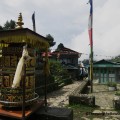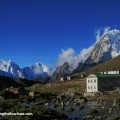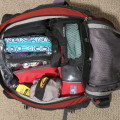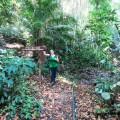Preparing for a multiday, high altitude trek can be tricky if you don’t have a reference on what is needed. Typically, I try to do my research well in advance for my adventures, but considering I signed up for this trek on a whim and left 2 days later, there wasn’t much time for that. Overall, I did very well packing and hope this list is helpful to anyone that is considering trekking to Everest Base Camp. There are a few points to consider about my trek if you are using this as a reference for your own trip.
- Season: Late August – early September. It was still monsoon season with almost daily afternoon rains, days were quite warm, the evenings were brisk.
- Length: 12 days – plenty of time to get to from Lukla – EBC – Lukla safely. Some trips are longer, although.
Here is what you could have found in my pack:
Clothing
- 2 quick dry T-shirts*
- 1 cotton T-shirt – something comfy and clean to sleep in (can also be used for photos at EBC if it is special)
- 2 quick dry long sleeved shirts – good for layering but I only ever used 1
- 1 fleece lined hoodie/jumper*
- 2 pairs of quick dry Trousers* – convertible can be handy (style takes a backseat here folks)
- 1 pair of shorts – only ever wore for sleeping, probably unnecessary especially if you have convertible trousers
- 2 Sports Bras
- 6 pairs quick dry Underwear
- 3 pairs heavy Socks* – rotate while trekking
- 1 pair regular Socks – when you just need clean, non-smelly feet
- Thermal pants* – nice to sleep in at higher elevations
- Raincoat
- Down Jacket* – rented and wore just once at the summit of Kala Patthar
- Winter hat – good to sleep in at higher elevations to avoid getting sick
- Gloves* – used once
Footwear
- Trekking boots^ – spoiler alert: I didn’t wear these once!
- Light hikers – these are the shoes I have been traveling with for the last few months
- Flip flops – for downtime at teahouses
Toiletries
- Shampoo and conditioner (small bottles)
- Soap
- Toothbrush/toothpaste
- Razor
- Deodorant
- Sunscreen
- Wet wipes – think bath time…
- Toilet paper
- Small med kit (ibuprofen, Cipro, band aids/plasters, moleskin, surgical tape, Neosporin, nail clippers)
Electronics
- iPad – for ebooks, uploading photos
- iPhone – you will actually get reception periodically on the way up (the best at Gorak Shep!) if you have a SIM card
- Headphones
- Camera
- Chargers
Other
- Bag, size small* – for all your gear to be carried by your porter
- Daypack – for you to carry
- 2 Water Bottles* – one Nalgene style (for easy Steripen purification) and one Swix style (metal – can put hot water in it and in your bed with you at night, if you need more warmth)
- Camelbak* – a MUST, in my opinion. Allows you to drink water easily while trekking
- Steripen – I HIGHLY recommend a Steripen for water purification. I used mine every time and never once got sick. You are able to drink the water right after purifying whereas with water purification tablets you usually need to wait 30 minutes and sometimes get a lovely taste as an added bonus
- Pack cover for daypack
- Silk sleep sheet – never used. I’ve heard during high season the blankets can get quite ripe/smelly from repeated use of sweaty trekkers.
- Headlamp
- Hat
- Wallet
- Book
- Map – fun to track your progress
- Playing cards
- Journal & pen
Total Weight of my Main Bag = 6kg (with down jacket added, ~7kg)
Daypack = 4kg
You will be limited to approximately 15kg of luggage for your flight to Lukla. When you see the plane and understand the airport you are flying into, you will understand why!
One thing I have learned after traveling for 7 months is to not over pack. You WILL go days without showering and you WILL sweat. Get comfortable with being a little stinky because everyone else will be too. Nearly every other traveler I met had bags weighing in at 15kgs and above. Granted, some had sleeping bags but I couldn’t figure out for the life of me what else I would have needed to carry, let alone enough to double the weight of my bag! Do yourself and your porter a favor and DO NOT over pack.
Stocking Up
I have been traveling the last 7 months with a 46 liter pack so, as you can imagine, I did not have a lot of the essential clothing and supplies needed for the trek. But, no worries…there are shops selling “authentic” trekking equipment every 50m in Kathmandu. After I signed up for my trek, I was taken to a shop that my company uses for all their customers. I got all the items indicted with a (*) above for $100. I thought it was a very fair price. Please be aware, all of this stuff is knock off and if it says waterproof, it likely is not. Buy a rain cover for it if you are worried about things getting wet and don’t expect them to hold up much beyond your trek.
My biggest fear was not the hours of trekking each day or even getting altitude sickness….it was having to buy trekking boots and wearing them for 12 days without ever haven taken a step in them prior. As a fairly experienced trekker, wearing boots that are not broken in is pretty much a cardinal sin. My guide highly advised that they were necessary, so I caved at bought ‘North Face’ boots at 4500Rs. I was told that I could probably get by in my shoes for the first day or two and after that I would likely need the boots. I would soon find out that I didn’t really need them at all…
Namche Bazaar will be your last decent shopping opportunity as you head up the mountain (you will likely spend two days here to acclimatize). The prices will be higher than in Kathmandu, but still fairly reasonable. There are decent sized stores that carry snack foods, gear, and books. There is also a pharmacy if you need any medical items. My advice: Grab an extra roll of toilet paper and a couple candy bars and you’ll be set!
Helpful Tips:
- RENTING GEAR: It is possible to rent some of the more expensive, but necessary items in Kathmandu (and even Namche). Down jackets and sleeping bags can be rented at daily rates. Jackets went for about 100Rs/day from Kathmandu or 150Rs from Namche. Please note that if you think you will need one of these, it is advisable to rent one from KTM and bring it with you. I found just 2 shops in Namche that were willing to rent equipment in Namche.
- SLEEPING BAG: I did not pack a sleeping bag but rather used blankets at all of the tea houses and was MORE than warm. I have heard that during high season blankets are hard to come by and sleeping bags are more important.
- WATER: You are able to drink tap water at nearly every teahouse (once purified). I was advised that it was not good to Dughla and Gorak Shep. The Steripen saved me a ton of money and time as you need to drink, on average, five liters of water a day.
- CHARGING: You will be able to charge your electronics wherever you stay, but there will be a cost. At the bottom of the trek (Phadking), you can get a full charge for 200Rs. Once you get higher up (Gorak Shep), it will cost you about 350Rs an hour. I can imagine in high season it would also be a fight for charging time.
- SHOWERS: I had 1 hot bucket bath during the 8 day trek up and 1 warm bucket bath and 1 hot shower on the way back down AND this was low season! Be advised….hot water is VERY limited and if it is crowded, you might not get any (the water ran out on me mid shower once, hence a 2nd bucket shower!) Get used to wet wipe baths each evening.
- HEAT: Nearly every teahouse has a central dining room which also has a poo powered stove for heat. They will usually fire these up in the evening, but it can still be quite chilly. I do not get cold easily and layering up in a couple of shirts was enough for me, but there were several others that wore hats, down jackets, double layered pants and socks and were still cold. There is no heat in the individual rooms, so either wear layers to bed or find a cuddle buddy! 🙂
Any critical items that others have found useful in their trek? Share them in the comments for others to see!







Great lists. Thanks. With your quick drying stuff, did you have a chance to or did you try to wash any of your clothes during the trek?
John recently posted…Travel & Altitude Medications
Hey John! I’m glad you found the list helpful. I didn’t even try to wash anything. I’m not a major sweater, but it was all stinky by day 6. Frankly, it seemed like it would be a futile effort. You might have time for things to dry if you have an acclimatization day and good weather. Otherwise, you’ll just have wet clothes. Embrace the stink 🙂
Do you think Febreze might help?
Yeah, it would probably help. but, just bring the smallest bottle you can find. If you are worried about things getting stinky, maybe throw some scented dryer sheets into your bag. I bet that would help with the odor. Believe me, the bag will smell. Also, keep in mind if you are trekking when it is cooler, you may sweat less. It was quite warm while I was trekking.
Oh, one more thing. You used a water bladder? I’ve heard people say they had problems with the tubing freezing at higher altitudes and thus recommended using bottles. Did you experience this at all?
John recently posted…Travel & Altitude Medications
I would definitely bring water bottles as they are the most reliable. My water bladder was crucial for me to be able to drink continuously throughout the day and avoid chugging on breaks. With that said, our weather was beautiful and there was no concern for freezing conditions. I ski with an insulated water bladder in the winter and those do a decent job of not freezing (especially if constantly drinking). I would bring one, use it while trekking, and drain it at night so it doesn’t freeze. You’ll be glad you have it!
nice list